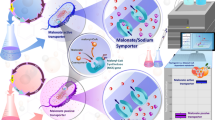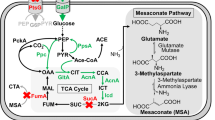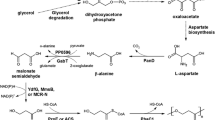Abstract
Escherichia coli is an attractive candidate as a host for polyketide production and has been engineered to produce the erythromycin precursor polyketide 6-deoxyerythronolide B (6dEB). In order to identify and optimize parameters that affect polyketide production in engineered E. coli, we first investigated the supply of the extender unit (2S)-methylmalonyl-CoA via three independent pathways. Expression of the Streptomyces coelicolor malonyl/methylmalonyl-CoA ligase (matB) pathway in E. coli together with methylmalonate feeding resulted in the accumulation of intracellular methylmalonyl-CoA to as much as 90% of the acyl-CoA pool. Surprisingly, the methylmalonyl-CoA generated from the matB pathway was not converted into 6dEB. In strains expressing either the S. coelicolor propionyl-CoA carboxylase (PCC) pathway or the Propionibacteria shermanii methylmalonyl-CoA mutase/epimerase pathway, methylmalonyl-CoA accumulated up to 30% of the total acyl-CoA pools, and 6dEB was produced; titers were fivefold higher when strains contained the PCC pathway rather than the mutase pathway. When the PCC and mutase pathways were expressed simultaneously, the PCC pathway predominated, as indicated by greater flux of 13C-propionate into 6dEB through the PCC pathway. To further optimize the E. coli production strain, we improved 6dEB titers by integrating the PCC and mutase pathways into the E. coli chromosome and by expressing the 6-deoxyerythronolide B synthase (DEBS) genes from a stable plasmid system.




Similar content being viewed by others
References
An JH, Kim YS (1998) A gene cluster encoding malonyl-CoA decarboxylase (MatA), malonyl-CoA synthetase (MatB) and a putative dicarboxylate carrier protein (MatC) in Rhizobium trifolii--cloning, sequencing, and expression of the enzymes in Escherichia coli. Eur J Biochem 257:395–402
Cronan JEJ, LaPorte DC (1996)Tricarboxylic acid cycle and glyoxylate bypass. In: Neidhardt FC (ed) Escherichia coli and Salmonella typhimurium: cellular and molecular biology, 2nd edn. American Society for Microbiology, Washington, D.C., pp 206–216
Dayem LC, et al (2002) Metabolic engineering of a methylmalonyl-CoA mutase-epimerase pathway for complex polyketide biosynthesis in Escherichia coli. Biochemistry 41:5193–5201
Desai RP, et al (2002) Enhanced production of heterologous macrolide aglycones by fed-batch cultivation of Streptomyces coelicolor. J Ind Microbiol Biotechnol 28:297–301
Haller T, et al (2000) Discovering new enzymes and metabolic pathways: conversion of succinate to propionate by Escherichia coli. Biochemistry 39:4622–4629
Jackowski S, Rock CO (1981) Regulation of coenzyme A biosynthesis. J Bacteriol 148:926–932
Jacobsen JR, et al (1997) Precursor-directed biosynthesis of erythromycin analogs by an engineered polyketide synthase. Science 277:367–369
Jones KL, Kim SW, Keasling JD (2000) Low-copy plasmids can perform as well as or better than high-copy plasmids for metabolic engineering of bacteria. Metab Eng 2:328–338
Kealey JT, et al (1998) Production of a polyketide natural product in nonpolyketide-producing prokaryotic and eukaryotic hosts. Proc Natl Acad Sci USA 95:505–509
Khlebnikov A, et al (2001) Homogeneous expression of the P(BAD) promoter in Escherichia coli by constitutive expression of the low-affinity high-capacity AraE transporter. Microbiology 147:3241–3247
Leadlay PF (1981) Purification and characterization of methylmalonyl-CoA epimerase from Propionibacterium shermanii. Biochem J 197:413–419
Link AJ, Phillips D, Church GM (1997) Methods for generating precise deletions and insertions in the genome of wild-type Escherichia coli: application to open reading frame characterization. J Bacteriol 179:6228–6237
Magrini V, et al (1998) The aadA gene of plasmid R100 confers resistance to spectinomycin and streptomycin in Myxococcus xanthus. J Bacteriol 180:6757–6760
McKie N, et al (1990). Adenosylcobalamin-dependent methylmalonyl-CoA mutase from Propionibacterium shermanii. Active holoenzyme produced from Escherichia coli. Biochem J 269:293–298
Morgan-Kiss RM, Wadler C, Cronan JE Jr (2002) Long-term and homogeneous regulation of the Escherichia coli araBAD promoter by use of a lactose transporter of relaxed specificity. Proc Natl Acad Sci USA 99:7373–7377
O'Hagan D (1991) The polyketide metabolites. Ellis Horwood, Chichester
Pfeifer BA, et al (2001) Biosynthesis of complex polyketides in a metabolically engineered strain of E. coli. Science 291:1790–1792
Pfeifer B, et al (2002) Process and metabolic strategies for improved production of Escherichia coli-derived 6-deoxyerythronolide B. Appl Environ Microbiol 68:3287–3292
Rodriguez E, Gramajo H (1999) Genetic and biochemical characterization of the alpha and beta components of a propionyl-CoA carboxylase complex of Streptomyces coelicolor A3(2). Microbiology 145:3109–3119
Scholz P, et al (1989) Complete nucleotide sequence and gene organization of the broad-host-range plasmid RSF1010. Gene 75:271–288
Smolke CD, Keasling JD (2002) Effect of copy number and mRNA processing and stabilization on transcript and protein levels from an engineered dual-gene operon. Biotechnol Bioeng 78:412–424
Smolke CD, Martin VJ, Keasling JD (2001) Controlling the metabolic flux through the carotenoid pathway using directed mRNA processing and stabilization. Metab Eng 3:313–321
Xue Q, et al (1999) A multiplasmid approach to preparing large libraries of polyketides. Proc Natl Acad Sci USA 96:11740–11745
Acknowledgements
We thank Sarah Mutka, Janice Lau, Misty Piagentini and Andreas Schirmer of Kosan Biosciences for providing plasmids and results prior to publication, and Richard Hutchinson and Leonard Katz of Kosan Biosciences for critically reading the manuscript.
Author information
Authors and Affiliations
Corresponding author
Additional information
S. Murli and J. Kennedy contributed equally to this work
Rights and permissions
About this article
Cite this article
Murli, S., Kennedy, J., Dayem, L.C. et al. Metabolic engineering of Escherichia coli for improved 6-deoxyerythronolide B production. J IND MICROBIOL BIOTECHNOL 30, 500–509 (2003). https://doi.org/10.1007/s10295-003-0073-x
Received:
Accepted:
Published:
Issue Date:
DOI: https://doi.org/10.1007/s10295-003-0073-x




